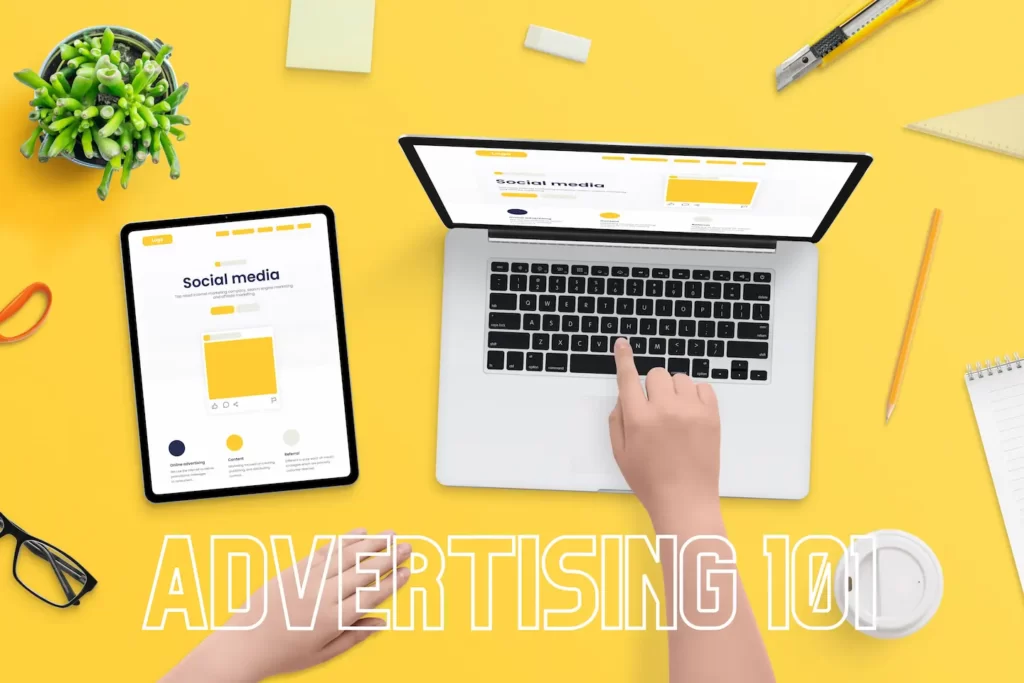Advertising 101
Ever noticed how that catchy jingle from a TV commercial somehow finds its way into your head, or how that vibrant billboard makes you consider buying a product? That’s the power of advertising. Since the ancient days of papyrus promotions in Egypt, advertising has transformed dramatically, adjusting to the changing tastes, mediums, and technologies. In this article, we’ll dive deep into the vibrant world of advertising, exploring its types, mediums, and a few handy tips to get you started.
What is Advertising?
Advertising, in simple terms, is the act of promoting a product, service, or idea to a target audience. Think of it as the bridge connecting a brand or business to its potential customers. Its primary role? To drive action. Be it purchasing a product, signing up for a service, or simply creating brand awareness, advertising holds immense importance in shaping the consumer economy. Every product you’ve ever bought, every service you’ve ever used – they’ve all reached you, one way or another, through advertising.
The Different Types of Advertising
Traditional Advertising:
- Print: This includes magazines, newspapers, brochures, and any other printed medium. Remember the last time you found a tempting discount coupon in a magazine? That’s print advertising in action.
- TV: One of the most popular mediums, TV advertising showcases products through captivating visuals and sounds, reaching audiences right in their living rooms.
- Radio: These are the audio ads that you hear between your favorite songs. Simple yet effective, especially when you want to reach a local audience.
Digital Advertising:
- Display Ads: These are the banner ads you see on websites. From promoting the latest gadgets to vacation deals, they aim to catch your attention as you browse the internet.
- Social Media Ads: Ads on platforms like Facebook, Instagram, or Twitter that are tailored to fit the platform’s style and its users. Ever seen a product ad while scrolling through your feed? That’s social media advertising at play.
- Guerrilla Advertising: Think unconventional. These are surprise, often interactive elements that catch you off-guard in public places. For example, a large 3D shoe in the middle of a square promoting a shoe brand.
- Outdoor Advertising: Billboards, posters, or bus stop ads, these are large-format ads aiming to catch your attention while you’re on the move.
Advertising is everywhere – from the newspaper you read in the morning to the social media feeds you scroll through at night. Understanding its basics will not only help businesses craft better campaigns but also make consumers more informed. Dive in, explore, and appreciate the vast realm of advertising.
The Importance of Target Audience
Before launching any advertising campaign, it’s crucial to know who you’re speaking to. Imagine trying to sell a brand-new video game to senior citizens, or perhaps retirement plans to teenagers. It might not work out, right?
- Identifying the Target Audience: This involves understanding who would most likely be interested in your product or service. Are they teenagers? Parents? Fitness enthusiasts? Office workers? Knowing this helps in tailoring your message to suit their interests, needs, and habits.
- How Audience Insights Drive Advertising Strategies: Once you know your audience, you can determine where they spend their time, what they like, and how they like to be approached. For instance, if you’re targeting teens, a vibrant ad on Instagram might be more effective than a print ad in a newspaper.
Ad Channels and Mediums
Just as a musician chooses the right instrument to convey a feeling, advertisers must choose the right channel to convey their message.
Choosing the Right Advertising Channels: Depending on your target audience, you might pick:
- TV: Great for a broad audience and visual storytelling.
- Print: Useful for detailed information, often favored by an older demographic.
- Online: Best for reaching a tech-savvy audience, offering precise targeting options.
- Importance of Medium Selection Based on Target Audience: Your chosen medium should align with where your audience spends most of their time. If your target audience loves reading, a detailed magazine ad might be the way to go. If they’re always online, then a catchy digital banner might be better.
Crafting an Effective Message
A well-crafted message can make the difference between an ad that’s ignored and one that’s acted upon.
Elements of a Compelling Ad:
- Headline: It’s the first thing people read. Make it catchy and relevant.
- Visuals: A picture is worth a thousand words, especially in advertising. Choose images that resonate with your audience.
- Call-to-Action (CTA): This is where you tell your audience what to do next – ‘Buy Now,’ ‘Learn More,’ or ‘Visit Us Today’ are all CTAs aiming to drive action.
- Importance of Messaging Consistency Across Platforms: Whether someone sees your ad on TV, reads about it in a magazine, or stumbles upon it online, the core message should be consistent. This reinforces brand recall and trust.
Metrics to Measure Success
How do you know if your ad worked? By measuring its success.
- Explanation of Key Performance Indicators (KPIs): KPIs are metrics that help advertisers understand how well their campaign is doing. This might include things like how many people saw the ad (reach), how many clicked on it (click-through rate), or how many actually bought the product (conversion rate).
- ROI and its Relevance in Advertising Campaigns: ROI, or Return on Investment, measures the money made versus the money spent on the ad campaign. It’s essential because it helps businesses understand if their advertising efforts are leading to profits. Simply put, if you’re spending more on ads than you’re earning back, something needs to change.
Advertising is a blend of art and science. By understanding its fundamentals, businesses can create impactful campaigns that resonate with their audience, drive action, and deliver results.
Advertising Budget and Planning
Every good plan starts with a budget. In advertising, your budget is the backbone of your campaign, influencing decisions, strategies, and outcomes.
The Role of Budgeting in Advertising: Budgeting ensures you have a clear view of how much you can spend and where you should spend it. Without a budget, you might end up spending too much on less effective channels and too little on ones that could yield results.
Tips on Allocating Resources Efficiently:
- Prioritize Platforms: If your target audience is more active on Instagram than on radio, then allocate more budget to Instagram advertising.
- Set Clear Objectives: Know what you want to achieve – be it brand awareness, sales, or leads. Allocate funds accordingly.
- Track and Adjust: Regularly check how your ads are performing. If something isn’t working, adjust your budget allocation.
Q&A: Common Questions About Advertising
Q: What is the most effective form of advertising for small businesses?
A: It largely depends on the target audience. Often, local advertising like flyers, local newspapers, or online ads targeting a specific area can be effective for small businesses. Social media platforms can also be a cost-effective way to reach a larger audience.
Q: How do you measure the success of an advertising campaign?
A: Success is measured using key performance indicators (KPIs) like reach, click-through rate, conversion rate, and return on investment (ROI).
Q: What are the main differences between traditional and digital advertising?
A: Traditional advertising includes mediums like TV, radio, and print, while digital covers online platforms like websites and social media. Digital advertising often allows for more precise targeting and immediate feedback on campaign performance.
Q: What are some common pitfalls to avoid in advertising?
A: Some pitfalls include not understanding your target audience, inconsistent messaging, setting unclear objectives, and not tracking or adjusting campaigns based on performance.
Q: How can you advertise effectively on a tight budget?
A: Focus on platforms where your audience is most active, create compelling organic content, utilize cost-effective online ads, and always measure and adjust based on performance.
Conclusion
Advertising is everywhere – from the billboard you pass on your way to work to the pop-up ad on your smartphone. Understanding its basics can significantly improve how businesses communicate with potential customers. Whether you’re a large corporation or a small local shop, the principles remain the same. Understand your audience, craft your message, choose the right platforms, set a budget, and always measure your results. As you dive into the world of advertising, remember these fundamentals and put them into action. Happy advertising!










